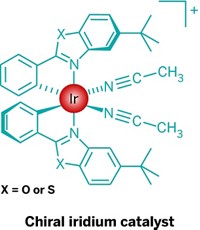Advertisement
Grab your lab coat. Let's get started
Welcome!
Welcome!
Create an account below to get 6 C&EN articles per month, receive newsletters and more - all free.
It seems this is your first time logging in online. Please enter the following information to continue.
As an ACS member you automatically get access to this site. All we need is few more details to create your reading experience.
Not you? Sign in with a different account.
Not you? Sign in with a different account.
ERROR 1
ERROR 1
ERROR 2
ERROR 2
ERROR 2
ERROR 2
ERROR 2
Password and Confirm password must match.
If you have an ACS member number, please enter it here so we can link this account to your membership. (optional)
ERROR 2
ACS values your privacy. By submitting your information, you are gaining access to C&EN and subscribing to our weekly newsletter. We use the information you provide to make your reading experience better, and we will never sell your data to third party members.
Synthesis
Light Steers Reaction Pathway
Changing a ligand’s electron-donating ability modulates organometallic catalyst’s activity
by Stu Borman
May 27, 2013
| A version of this story appeared in
Volume 91, Issue 21
A new type of organometallic catalyst can control the rates of hydroborations and potentially other reactions by using different wavelengths of light. The work may lead to distinct products with the flip of a light switch and may simplify multistep syntheses by using single catalysts in sequential reactions. Bethany M. Neilson and Christopher W. Bielawski of the University of Texas, Austin, achieved the organometallic photocontrol with an N-heterocyclic carbene (NHC) ligand bearing a photoresponsive group (Organometallics 2013, DOI: 10.1021/om400348h). When exposed to UV light, the group cyclizes, weakening NHC’s (shown, black) electron-donating ability and catalytic activity, whereas visible light opens the ring, enhancing NHC’s (red) electron donation and catalysis. Using NHC-metal complexes as photoswitchable catalysts was first suggested in 2009 by Vivian Wing-Wah Yam and coworkers at the University of Hong Kong (J. Am. Chem. Soc., DOI:10.1021/ja808791e). Similar reactions have been reported previously. But the new report is the first to control metal-catalyzed reactions by using NHCs and the first to do so by modifying a ligand’s electron-donating ability.





Join the conversation
Contact the reporter
Submit a Letter to the Editor for publication
Engage with us on Twitter